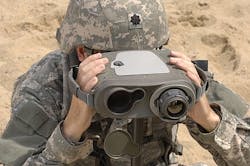Army chooses BAE Systems for handheld LTLM for target recognition in daylight and darkness
HUDSON, N.H., 28 Feb. 2012. U.S. Army officials needed laser targeting systems to help foot soldiers identify target locations in daylight or at night, as well as in obscured-visibility such as fog or smoke. They found their solution from the BAE Systems Electronic Systems segment in Hudson, N.H.
The Army awarded BAE Systems a $23 million contract to the provide lightweight handheld Laser Target Locator Module (LTLM). For the LTLM electro-optics contract, BAE Systems officials are providing the company's Target Reconnaissance Infra-Red Geolocating Rangefinder, or TRIGR, which helps soldiers determine target coordinates quickly and accurately, explains says Bill Ashe, the LTLM program manager at BAE Systems.
The TRIGR device for the Army's LTLM contract consists of an optical system, a night-vision camera derived from a BAE Systems thermal weapon sight, a laser range finder, a digital compass, and a Global Positioning System (GPS) receiver.
The TRIGR system, which looks like a pair of bulky binoculars, weighs less than 5.5 pounds and enables users to recognize targets more than two and a half miles away in daylight, and more than half a mile away in darkness.
BAE Systems received this contract after the company won a $72 million contract for initial production of the LTLM systems in 2009 from the U.S. Army's Program Executive Office Soldier. BAE Systems will do the work in Lexington, Mass., Nashua, N.H., and Austin, Texas.
Army officials plan to field the first LTLM units to soldiers in the field this month. For more information contact BAE Systems Electronic Systems online at www.baesystems.com.

